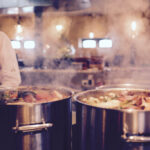
The other soba option is hot soba noodles served in a hot, flavorful broth. Classically speaking, you don’t want too much broth—because an old Japanese tradition holds that the diner who eats too much broth with his soba doesn’t appreciate the noodles themselves, and is probably an unsophisticate from the sticks. Don’t be afraid to slurp those noodles, however, which even the city slickers do—because slurping enables you to cool them as you eat them, which means you can eat them while they’re still hot, which means they won’t get soft in the broth as they sit waiting for you to deem them cool enough. Some Japanese diners like to add an egg to the soba experience; you can either break a raw one into each bowl of hot soba (stirring it in), or you can poach an egg for each bowl and float the poached eggs on top of the noodles.
SERVES 4
1 pound dried soba
5½ cups Noodle Broth (recipe follows)
4 tablespoons minced scallion
Shichimi togarashi (Japanese seven-spice mixture)
1. Bring a large stockpot of generously salted water to a boil and add the soba, stirring well to separate the noodles. Return the water to a boil. Add 1 cup of cold water and return to a boil again. Repeat the process of adding cold water and returning to a boil 2 or 3 more times, until the noodles are just tender but still firm to the bite. Place noodles in a colander. Immediately rinse the noodles under cold running water for a few minutes, massaging as you rinse, to release the surface starch. Drain the noodles well.
2. Divide the noodles among 4 large soup bowls. Divide the noodle broth evenly among the bowls, garnish each with minced scallion and a few pinches of shichimi. Serve immediately, passing additional shichimi at the table.
Noodle Broth
5¼ cups dashi
3 tablespoons plus 1 teaspoon dark soy sauce
1½ tablespoons mirin
1½ tablespoons sugar
1¼ teaspoons kosher salt
1. Combine all of the ingredients in a medium saucepan and bring just to a boil, stirring once or twice to dissolve the sugar and salt. Serve hot with soba noodles. Makes 5½ cups.
Dashi
Before you move on to other Japanese dishes, you’re going to need dashi. This seaweed-and-dried-fish stock is one of the fundamental elements of the Japanese kitchen; it is a building block for many, many dishes in the Japanese repertoire. Dashi is very simple to make; finding the ingredients is a whole lot trickier. But any good Japanese grocery will carry dried bonito flakes and kelp, a type of dried seaweed. Ironically, if you have access to those ingredients, you probably have access to something else as well: instant dashi powder, which is certainly the most acceptable powdered “stock” or “bouillon” of any kind that I’ve ever tasted.
2 quarts plus ¼ cup cold water
1½ ounces (45 grams) konbu
2 ounces dried bonito flakes
1. Place the 2 quarts of water and the konbu in a large saucepan over medium heat and bring to just under a boil.
2. Remove the konbu, add the ¼ cup of water and the bonito flakes. Again, bring the liquid to just under a boil. Then turn off the heat and let the mixture steep for 1 minute.
3. Pass the mixture through a fine mesh sieve. Dashi is best used right away but can be refrigerated for up to a week or frozen for about a month. Makes 2 quarts.


